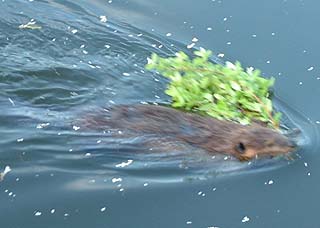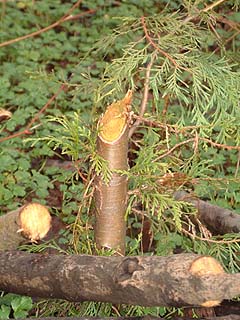
Surveys
DJC.COM
July 17, 2003
Beavers back in force in the Seattle area
Seattle Public Utilities

Photos courtesy of Seattle Public Utilities
A local beaver makes an appearance.
|
The voice on the end of the telephone line asked if his siding was safe — it was cedar after all. Streamside vegetation was falling fast, and large rhododendrons that took years to grow were damaged. Who was this mysterious midnight vandal?
Well, they're baaaaaack. Beavers are returning to Seattle creeks and backyards — sometimes with undesirable consequences for homeowners. That's right. Beavers. As beaver populations increase and urban habitat is improved, these territorial critters are returning in earnest to our local waterways.
Scattered populations of beavers exist throughout Seattle. One of the most notable areas is in Lake Washington adjacent to the 520 bridge and the Arboretum. A quick glance at the areas near the mouths of Longfellow and Thornton creeks reveals telltale signs of beaver presence — fallen cottonwoods, gnawed alders and floating, barkless, pointy sticks.
Beavers are living “link-side” at Jackson Park and West Seattle golf courses, and the “Cleaver” family lodge at Lake City's Meadowbrook Pond draws an audience throughout the summer.
| Report a beaver |
|
To report beaver activity on Seattle creeks,
call (206) 684-4163.
To report trapping or poisoning of beavers, call the Department of Fish and Wildlife's Poaching Hotline at (800) 477-6224. For more information on Seattle Public Utilities Creek Steward program, call (206) 684-4163 or visit www.seattle.gov/util/urbancreeks/. |
As an increasing population of furry chewing machines comes in contact with a large and settled human population, you have a guaranteed recipe for human-beaver conflict.
At Seattle Public Utilities, the Creek Steward program has become one recipient of citizen phone calls about beavers. The program has a broad mission to provide opportunities for people to learn about and get involved in taking care of Seattle's urban creeks. Through the 2-year-old program, volunteers can adopt a site on the creek, help out at a planting or weeding work party, train to be a volunteer monitor, or attend a workshop on “creek friendly” practices.
After a few phone calls about beavers, it became apparent that there was a need for more understanding of the beaver lifestyle, why they do what they do, why merely trapping them wouldn't work, and how to thwart beaver damage along city creeks.
In the last year, reports of beaver activity were so numerous that a “Living with Beavers” workshop and a “Meet the Beavers” naturalist walk were offered earlier this year in partnership with Seattle Parks, the Homewaters Project and Thornton Creek Alliance.
While the state Department of Fish and Wildlife has jurisdiction over beavers, the utility has adopted a position of tolerance towards the beavers, provided they don't pose a danger to public health, property or migrating salmonids. The following is useful information on living with beavers.
Got beaver?
Telltale gnawing, trees left looking like pointy sticks and dams appearing across the backyard creek are usually pretty obvious. Beavers are rodents, and their teeth grow constantly and must be worn down, lest they grow right through their heads. Beavers naturally like to chew things; it’s how they get their food. Most often, they're in search of the tender, sweet cambium layer of a tree or shrub.
While individual beavers may have specific preferences, overall beaver favorites include willow, cottonwood, western red cedar, alder and maple. However, beavers won't discriminate between plants when needing to gnaw, so the occasional shrubbery falls victim to those curvaceous orange choppers.
To many people, the first option that springs to mind is to trap the beaver. The perennial solution, beavers have historically been trapped throughout North America for their fur. Trapping, however, is an expensive and “forever” proposition because beavers are territorial animals. Every beaver taken from good habitat creates an unoccupied vacuum until the next beaver shows up.
Each year, a beaver family has two to five “kits” or baby beavers. Together with the previous year's offspring they comprise a family unit — until next year’s kits are born and the older kits driven away by the parents. At this point, a young beaver will travel up to 10 miles over land and water to find and establish a new territory. It's during this time that a lot of the collateral damage to home landscapes occurs.
Protections
Remember the last time you took a long road trip? How you would prefer to eat something you really enjoyed, but you were so hungry you ended up grabbing a couple of overheated corn dogs and greasy whatnots from the only open place you passed? I would assume it's similar for the beavers, with the anecdotal reports of ornamental shrubs and “less preferred foods” like Douglas fir being eaten as the beavers travel or go hungry at the end of winter.

A cedar tree chewed in half by a beaver.
|
So what can a homeowner do? One option is to join 'em. If you live along a stream, plant the streamside area with plants that beavers like, intending the beavers to fill up on them before they get near your other plantings. A bonus associated with this strategy is that streamside native plantings provide good habitat for fish and other critters.
Physical barriers are another method to protect favorite trees and shrubs. Installing 2-by-4-inch mesh fencing wire supported by metal fence stakes has been proven effective, provided the fence is placed sufficiently far away from the trunk of the tree or shrub. Another method is to paint trunks of larger, established trees with “sand paint,” which is a mix of 8 ounces of mason sand mixed into a quart of latex paint.
And dams? Beaver dams cannot be removed without a hydraulic permit from the state Department of Fish and Wildlife. On the bright side, flows in urban stream systems are usually sufficient to wash out all but the most stalwart of beaver dams, so they usually don't become a problem.
A final note, poisoning beavers is prohibited in the state of Washington. A special trapping permit is required to trap nuisance animals.
With any luck your landscape will be safe, and you'll be able to enjoy these animals as indicators of a recovering natural system and healthier urban habitat.
Bob Spencer coordinates the Creek Steward program at Seattle Public Utilities.
Other Stories:
- Battle over keeping dams rages on
- What’s your vision for Seattle’s future?
- Hat Island gets a drink from the sea
- Foss Waterway cleanup kicks into high gear
- Reclaimed water — a ‘new’ water supply
- LOTT dives into reclaimed water
- Clean air: saving our competitive advantage
- Europe points the way to sustainability
- Old maps handy for site investigations
- Planning for an environmental emergency
- Engineered logjams: salvation for salmon
- Pierce County maps where its rivers move
- Be prepared with a spill management plan
- Development can be beneficial to wetlands
- Check out properties with microbial surveys
- Charting a sustainable course for the Sound
- Water rights no longer a hidden asset
- The economics of sustainability
- Laying the path for responsible education
- Squeezing more out of renewable energy
- Controlling mosquitos and the environment
- Our future: no time or resources to waste
- Port Townsend dock promotes fish habitat
- Brownfields program is here to stay
- Master Builders teaches green homebuilding
- Sculpting a park out of a brownfield
- A salmon-friendly solution on the Snake
Copyright ©2009 Seattle Daily Journal and DJC.COM.
Comments? Questions? Contact us.